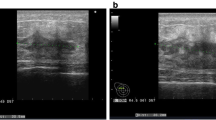Abstract
Angiosarcoma of the breast is a rare disease, and approximately 1 % of all affected patients are treated with breast-conserving therapy (BCT) and radiotherapy (RT) for primary breast cancer. The prognosis for this tumor is quite dismal, with high rates of recurrence and poor overall survival. This report presents the case of a 73-year-old female who underwent BCT followed by RT for left breast carcinoma 18 years previously. The patient visited the hospital with a complaint of a new mass in the left breast. The lesion initially decreased in size; however, it subsequently began to rapidly enlarge. A core needle biopsy of the mass was performed under ultrasonography, with a diagnosis of a spindle cell sarcoma, most conceivably an angiosarcoma, originating from the left breast, suspected to be induced by RT. The tumor was resected with the surrounding skin, and immunohistochemically diagnosed as angiosarcoma of the left breast, without evidence of breast cancer in any lesion, suggesting that RT induced the tumor formation. We herein report this rare case and the ultrasound imaging findings.



Similar content being viewed by others
Abbreviations
- BCT:
-
Breast-conserving therapy
- RT:
-
Radiotherapy
- CT:
-
Computed tomography
- MRI:
-
Magnetic resonance imaging
References
Cil T, Altintas A, Pasa S, et al. Primary Spindle Cell Sarcoma of the Breast. Breast Care. 2008;3:197–9.
D’Angelo SP, Antonescu CR, Kuk D, et al. High-risk features in radiation-associated breast angiosarcomas. Br J Cancer. 2013;9:2340–6.
Smith TL, Morris CG, Mendenhall NP. Angiosarcoma after breast-conserving therapy: long-term disease control and late effects with hyperfractionated accelerated re-irradiation HART. Acta Oncol. 2014;2:235–41.
Aljarrah A, Nos C, Clough KB, et al. A case report on radiation-induced angiosarcoma of breast post skin-sparing mastectomy and reconstruction with transverse rectus abdominal muscle. Ecancermedicalscience. 2014.
West JG, Qureshi A, West JE, et al. Risk of angiosarcoma following breast conservation: a clinical alert. Breast J. 2005;2:115–23.
Kim SW, Wylie J. Spontaneous regression of pulmonary metastases from breast angiosarcoma. Sarcoma. 2008. doi:10.1155/2008/940656.
Tanaka A, Tanemura A, Tsuji C, et al. Epithelioid angiosarcoma of the skin with spontaneous regression. J Dermatol. 2013;40:215–7.
Lakhani SR, Ellis IO, Schnitt SJ, et al. World Health Organization classification of tumors, tumors of the breast. 4th ed. Lyon: IARC Press; 2012. p. 135–6.
Yang WT, Hennessy BTJ, Dryden MJ, et al. Mammary Angiosarcomas: imaging Findings in 24 Patients. Radiology. 2007;3:725–34.
Kadouri L, Sagi M, Goldberg Y, et al. Genetic predisposition to radiation induced sarcoma: possible role for BRCA and p53 mutations. Breast Cancer Treat. 2013;1:207–11.
Gonin-Laurent N, Hadj-Hamou NS, Vogt N, et al. RB1 and TP53 pathways in radiation-induced sarcomas. Oncogene. 2007;41:6106–12.
Conflict of interest
The authors fully declare no potential conflict of interest to disclose.
Ethical standard
Written informed consent was obtained from the patient for publication of this report.
Author information
Authors and Affiliations
Corresponding author
About this article
Cite this article
Tanaka, Y., Uchida, A., Umemoto, T. et al. Spontaneous regression of breast angiosarcoma after conservative treatment with radiotherapy: a case report and review of the literature. J Med Ultrasonics 42, 427–432 (2015). https://doi.org/10.1007/s10396-014-0607-z
Received:
Accepted:
Published:
Issue Date:
DOI: https://doi.org/10.1007/s10396-014-0607-z




